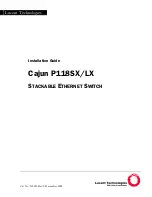
CMG-DCM
Once the operating system is loaded, the main Flash memory blocks (where
present) are mounted on
/nand0
and
/nand1
. Incoming data, which may be
from several sources, is combined into a single stream and placed in one of
these blocks (whichever is less full). When in use, you can expect each to be
between 50% and 75% full, with several da:ta files present. If the DCM is using
GCF as its storage file format (recommended; see
Section 4.2, “Disk”
), then
each file will be named after the timestamp on its first packet of data, in the
following fashion:
file-yyyymmdd-jjj-s-cccccccc.gcf
where
yyyymmdd
represents
the date of the earliest data packet in the file,
jjj
the number of full days
elapsed since midnight on January 1,
s
the time segment within the day (each
day is divided into eight 3-hour segments), and
cccccccc
a unique
hexadecimal code included to ensure filenames do not coincide.
When one of the Flash memory blocks approaches capacity, or after a fixed
time period (if you have so configured it; see
Section 4.2, “Disk”
) the DCM will
automatically move them onto the primary USB hard disk. This may be either
an internal Lacie hard disk, or an external drive connected to the module
through a USB client interface. This disk uses a specially-designed journalled
filesystem, which is designed to maintain the integrity of your data at all times.
Even if a write operation fails or is aborted suddenly, the disk will still contain a
valid filesystem with all previously-saved data intact, which can be read using
any driver that supports FAT32.
There is a set of specialised commands which allow you to perform basic tasks
on this filesystem:
gfat32df
: Displays the size of the filesystem, and how much free space
remains, in a format similar to this:
FAT32 filesystem has 15 G bytes free
Partition is 37 G bytes (78140097 blocks of 512 bytes)
If no suitable storage medium can be found, you will see the message
Failed
to find a USB disk
.
diskman
: Ensures that the
/nandx
partitions do not become full by moving
files when necessary. This program ordinarily runs constantly in the
background. However, a user can use the command
diskman -f
to force the
Flash memory to be entirely copied to the USB disk. Typing
diskman -f
is
identical to clicking the Flush flash button on the Disk tools page (see
“Flush
flash” in Section 5.3
). It does not remove data from the Flash memory. If you
issue
diskman -f
and then swap hard disks, the data remaining in memory
will later be written out to the new hard disk, causing some overlap between it
and the old disk.
84
Issue A














































